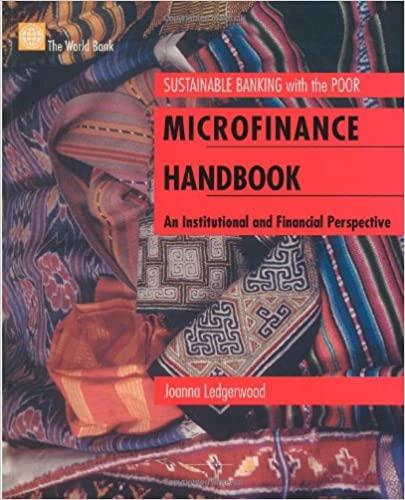Question
After three centuries under the rule of Portugal, Brazil became an independent nation in 1822. By far the largest and most populous country in South
After three centuries under the rule of Portugal, Brazil became an independent nation in 1822. By far the largest and most populous country in South America, with a population of over 205 million, Brazil has overcome more than a half century of military intervention in the gover- nance of the country to pursue industrial and agricultural growth and the development of the interior. After crafting a fiscal adjustment program and pledg- ing progress on structural reform, Brazil received a $41.5 billion IMF-led international support program in November 1998. In January 1999, the Brazilian Central Bank announced that the real would no longer be pegged to the U.S. dollar. The consequent devaluation helped moderate the downturn in economic growth in 1999, and the coun- try posted moderate GDP growth in 2000. Economic growth slowed considerably in 20012003to less than 2 percentbecause of a slowdown in major markets and the hiking of interest rates by the Central Bank to combat inflationary pressures. President Luiz Incio Lula da Silva, who took office on January 1, 2003, gave high pri- ority to reforming the complex tax code, trimming the overblown civil service pension system, and continuing the fight against inflation. By exploiting vast natural resources and a large labor pool, Brazil is today South Americas leading economic power and a regional bell- wether as it continues toward a free-market society. After winning a landslide victory in 2002 on a cam- paign to revamp the economy and battle for the poor, President Lula da Silva reassured worried investors when he continued his predecessors plan of strict financial aus- terity. Instead of catching the jitters as predicted, the countrys bond and stock markets enjoyed stellar returns in 2003 and are still going strong. But within a year, pres- sure was mounting on Lula da Silva to keep true to his populist roots. After riding a wave of popular support through his first year, Lula da Silva faced some criticism from within his own Workers Party and governing coali- tion as well as from ordinary voters. Lula has also gained a reputation for being thin-skinned when it comes to criticism; he expelled a foreign journalist critical of his policies. Although Lulas popularity dipped through this period, da Silva was reelected in 2006, and received more votes than any other Brazilian elected president. During his second term, Brazil continued its progress in modern- ization and da Silvas support gained steam again. In 2010, da Silva entered the final year of his second four- year term as one of the most popular Brazilian politicians of all time. But in Latin America, any change in leader- ship is always met with nervousness from financial mar- kets because it creates uncertainty and reminds business of previous transitions that have been disruptive. Brazils economy rebounded sharply from the global economic recession in 2009, with GDP growth of 2.7 per- cent and unemployment of 6 percent in 2011. With a GDP of US$2.5 trillion, Brazil ranks ninth globally in GDP in terms of purchasing power parity. According to The Econ- omist, Brazil is likely to become the worlds fifth largest economy, overtaking Britain and France before 2025. Brazils progress in fighting poverty has been one of the most impressive of any developing country. Brazil boasts a number of world class companies, including Embraer, the global leader in short- and mid-range jet aircraft. In addi- tion, Brazil will be host to the World Cup soccer match in 2014 and Rio will host the summer Olympic games in 2016. Substantial infrastructure investment is expected in advance of these two events. Brazil announced in early 2007 the discovery of the Tupi and Carioca oil fields off the coast of Rio de Janeiro. The oil reserves in these fields are con- servatively estimated at between 30 billion and 80 billion barrels, which would put Brazil in the top ten countries in the world by reserves. In May of 2010, Brazil announced another large discovery in the Santos Basin. By 2012, oil exports exceeded 800,000 bbl/day, making Brazil the 24th largest oil exporter globally. Output from the existing Campos Basin and the discovery of the new fields could make Brazil an even more significant oil exporter by 2015. Brazils national oil company, Petrobras, is one of the larg- est in the world. The government has created a new state- owned company called Petrosal to manage licensing in the new fields. This new company will award some explora- tion and production rights straight to Petrobras without options for foreign firms. Also, by mandate, it will award over half of the shallow-water contracts to locally owned Oil Service Companies (LOSCs). In deeper and more challenging waters beyond the capacity of local companies, foreign companies will be invited to bid. Those pledging to incorporate Brazilian content would be more likely to succeed. Higher taxes and fees are expected as well. Nonetheless, this sector is likely to create substantial new opportunities for foreign firms in Brazil. Most recently, the government of President Delma Rousseff, who succeeded da Silva, has faced street pro- tests over corruption, taxation, and poor public services. While Brazil has made great strides, challenges remain.
1. In your opinion, is there still political uncertainty in Brazil?
2. What strategy would be the most useful to compa- nies interested in Brazilian investment?
Step by Step Solution
There are 3 Steps involved in it
Step: 1

Get Instant Access to Expert-Tailored Solutions
See step-by-step solutions with expert insights and AI powered tools for academic success
Step: 2

Step: 3

Ace Your Homework with AI
Get the answers you need in no time with our AI-driven, step-by-step assistance
Get Started


